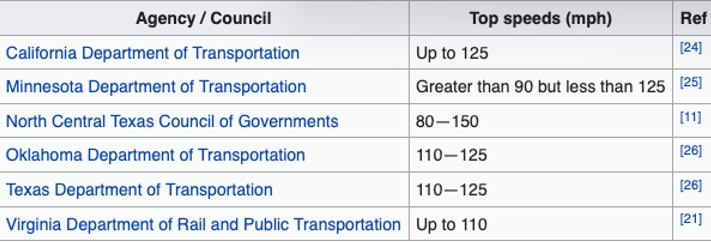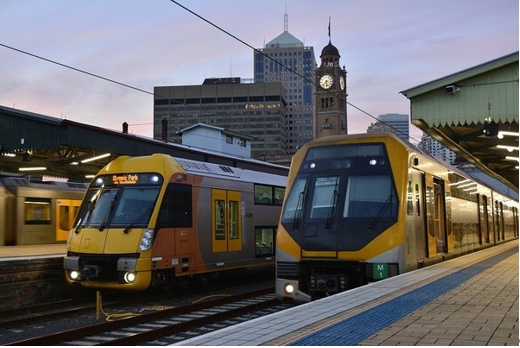 子弹头列车比普通列车快多少?
子弹头列车比普通列车快多少?
正文翻译
How much faster is a bullet train than a regular train?
子弹头列车比普通列车快多少?
子弹头列车比普通列车快多少?
评论翻译

As you can see, they vary a lot, going as low as 80mph (about 130km/h) and as high as 150mph (240 km/h), even higher than the most widely accepted definition of high-speed rail. An example of a higher-speed rail service is the Northeast Regional in America or the XPT in Australia.
Then you have your typical commuter rail. These are the trains that you use most frequently in commuting to work/school or general travel. They most often operate in and around cities.
正如您所看到的,这些列车速度差别很大,最低可达80英里每小时(约130公里/小时),最高可达150英里每小时(240公里/小时),甚至比最广泛接受的高速铁路定义还要高。一个更高速的铁路服务的例子是美国的东北地区列车或澳大利亚的XPT列车。然后你有典型的通勤铁路。这些是您在通勤上下班/上学或一般旅行中最常使用的火车。它们通常在城市内外运营。

Commuter trains in Sydney
悉尼的通勤火车
Willam Thorpe
By bullet train I’m assuming you’re talking about high speed trains in general. Internationally, high speed trains are generally defined as running at a speed of at least 200km/h (about 125mph). This can vary a bit; here in Australia, the Tilt Train is often called high-speed. It has a maximum in-service speed of 160km/h (about 100mph).
The next category is higher-speed rail – faster than a conventional commuter train but slower than a high-speed train. The definitions here vary quite a lot, here are some examples from the different US agencies:
我猜您说的子弹头列车指的是一般的高速列车。在国际上,高速列车一般被定义为运行速度至少为 200 公里/小时(约 125 英里/小时)。在澳大利亚,倾斜列车通常被称为高速列车。它的最高运行速度为 160km/h(约 100mph)。
下一类是高速铁路--比传统通勤列车快,但比高速列车慢。这里的定义差异很大,以下是美国不同机构提供的一些例子:
By bullet train I’m assuming you’re talking about high speed trains in general. Internationally, high speed trains are generally defined as running at a speed of at least 200km/h (about 125mph). This can vary a bit; here in Australia, the Tilt Train is often called high-speed. It has a maximum in-service speed of 160km/h (about 100mph).
The next category is higher-speed rail – faster than a conventional commuter train but slower than a high-speed train. The definitions here vary quite a lot, here are some examples from the different US agencies:
我猜您说的子弹头列车指的是一般的高速列车。在国际上,高速列车一般被定义为运行速度至少为 200 公里/小时(约 125 英里/小时)。在澳大利亚,倾斜列车通常被称为高速列车。它的最高运行速度为 160km/h(约 100mph)。
下一类是高速铁路--比传统通勤列车快,但比高速列车慢。这里的定义差异很大,以下是美国不同机构提供的一些例子:

As you can see, they vary a lot, going as low as 80mph (about 130km/h) and as high as 150mph (240 km/h), even higher than the most widely accepted definition of high-speed rail. An example of a higher-speed rail service is the Northeast Regional in America or the XPT in Australia.
Then you have your typical commuter rail. These are the trains that you use most frequently in commuting to work/school or general travel. They most often operate in and around cities.
正如您所看到的,这些列车速度差别很大,最低可达80英里每小时(约130公里/小时),最高可达150英里每小时(240公里/小时),甚至比最广泛接受的高速铁路定义还要高。一个更高速的铁路服务的例子是美国的东北地区列车或澳大利亚的XPT列车。然后你有典型的通勤铁路。这些是您在通勤上下班/上学或一般旅行中最常使用的火车。它们通常在城市内外运营。

Commuter trains in Sydney
悉尼的通勤火车
While there are no set speed definitions for commuter trains, they’re generally slower than higher-speed rail services. I’ll use my home city of Sydney as an example, as it has a quite extensive commuter rail network spanning around 1000km throughout the city. The highest posted speed limit is 115km/h (71mph) although usually trains will reach at most 80km/h (50mph) in the relatively short distances between suburban stations.
虽然通勤火车没有固定的速度定义,但它们通常比高速铁路服务慢。我以我家乡悉尼为例,因为它有一个相当广泛的通勤铁路网络,覆盖了城市内外约1000公里。最高限速为115公里/小时(71英里/小时),尽管通常列车在郊区站之间的相对短距离内最多只能达到80公里/小时(50英里/小时)。
虽然通勤火车没有固定的速度定义,但它们通常比高速铁路服务慢。我以我家乡悉尼为例,因为它有一个相当广泛的通勤铁路网络,覆盖了城市内外约1000公里。最高限速为115公里/小时(71英里/小时),尽管通常列车在郊区站之间的相对短距离内最多只能达到80公里/小时(50英里/小时)。
Using these examples, a high-speed train is at least 85km/h (53mph) faster than a commuter train. In reality, this is much more pronounced, as high-speed Acela Express trains in America reach 250km/h (155mph). Another example, the TGV in Europe, travels at 320km/h (200mph).
利用这些例子,高速列车至少比通勤列车快85公里/小时(53英里/小时)。实际上,这种差距更为明显,例如美国的高速列车Acela Express达到250公里/小时(155英里/小时)。另一个例子,欧洲的TGV列车以320公里/小时(200英里/小时)的速度行驶。
利用这些例子,高速列车至少比通勤列车快85公里/小时(53英里/小时)。实际上,这种差距更为明显,例如美国的高速列车Acela Express达到250公里/小时(155英里/小时)。另一个例子,欧洲的TGV列车以320公里/小时(200英里/小时)的速度行驶。
Alan Williams
What about the better comparisons; the international hi-speed trains: China, Japan, many European countries, many much faster then Australia and the US. The maglev hi-speed train from Shanghai city to Shanghai International Airport, well over 500 kph.
那么更好的比较是什么呢?国际高速列车:中国、日本、许多欧洲国家,很多都比澳大利亚和美国快得多。从上海市到上海国际机场的磁悬浮高速列车,时速超过500公里。
What about the better comparisons; the international hi-speed trains: China, Japan, many European countries, many much faster then Australia and the US. The maglev hi-speed train from Shanghai city to Shanghai International Airport, well over 500 kph.
那么更好的比较是什么呢?国际高速列车:中国、日本、许多欧洲国家,很多都比澳大利亚和美国快得多。从上海市到上海国际机场的磁悬浮高速列车,时速超过500公里。
William Thornton
Yes, America is not very advanced in high speed trains like we are in aviation.
是的,美国在高速列车方面不太发达,就像我们在航空方面一样。
Yes, America is not very advanced in high speed trains like we are in aviation.
是的,美国在高速列车方面不太发达,就像我们在航空方面一样。
Andy Duffell
I work for a passenger rail company that operates both “bullet trains” and conventional stock. In our case we’ve got Hitachi trains, and they build the actual Shinkansen bullet trains, so while it’s not a term you here used for our stock it’s basically what they are.
我在一家客运铁路公司工作,既有“子弹头”列车,也有普通车辆。在我们这种情况下,我们有日立列车,他们建造实际的新干线子弹头列车,所以虽然这个术语在我们的车辆中并没有被使用,但它基本上是描述我们的车辆的。
I work for a passenger rail company that operates both “bullet trains” and conventional stock. In our case we’ve got Hitachi trains, and they build the actual Shinkansen bullet trains, so while it’s not a term you here used for our stock it’s basically what they are.
我在一家客运铁路公司工作,既有“子弹头”列车,也有普通车辆。在我们这种情况下,我们有日立列车,他们建造实际的新干线子弹头列车,所以虽然这个术语在我们的车辆中并没有被使用,但它基本上是描述我们的车辆的。
Our normal trains are rated for either 75mph or 90mph, depending on whether they’re inner city or mainline stock. Our high speed units are rated for 140mph when they’re running on the actual high speed lines.
我们的普通列车的速度评级为75英里/小时或90英里/小时,取决于它们是城市内还是主干线车辆。我们的高速列车在实际的高速线路上运行时的速度评级为140英里/小时。
我们的普通列车的速度评级为75英里/小时或90英里/小时,取决于它们是城市内还是主干线车辆。我们的高速列车在实际的高速线路上运行时的速度评级为140英里/小时。
So compared to our suburban stock they’re nearly twice as fast, and compared to our mainline trains they’re about 55% faster. There is some stock operated by another company that runs on the same high speed lines as us though, and their new trains can hit the maximum line speed of 186mph, which is pretty quick.
因此,与我们的市郊车辆相比,它们快近一倍,与我们的主干线列车相比,它们大约快55%。但是,还有另一家公司运营的列车也在我们同样的高速线路上行驶,他们的新列车可以达到最大线路速度186英里/小时,这相当快。
因此,与我们的市郊车辆相比,它们快近一倍,与我们的主干线列车相比,它们大约快55%。但是,还有另一家公司运营的列车也在我们同样的高速线路上行驶,他们的新列车可以达到最大线路速度186英里/小时,这相当快。
Tom Gupta
It depends on what country you are in, along with the type of train and infrastructure (e.g. in the UK Virgin Class 390 Pendolinos, while they can reach 140mph they can go no faster than 125mph, less in some places due to rail infrastructure)
这取决于您所在的国家、列车类型和基础设施(例如,在英国,虽然Virgin Class 390 Pendolinos可以达到140英里/小时的速度,但由于铁路基础设施的限制,它们最快只能达到125英里/小时或更少)。
It depends on what country you are in, along with the type of train and infrastructure (e.g. in the UK Virgin Class 390 Pendolinos, while they can reach 140mph they can go no faster than 125mph, less in some places due to rail infrastructure)
这取决于您所在的国家、列车类型和基础设施(例如,在英国,虽然Virgin Class 390 Pendolinos可以达到140英里/小时的速度,但由于铁路基础设施的限制,它们最快只能达到125英里/小时或更少)。
Anyway, the Original Type 0 Japanese Bullet train, part of the Shinkansen family, which entered service in 1964 has a maximum operating speed of 135mph, with a maximum speed of 137mph (FYI in the UK the fastest tracks are on HS1 and trains can reach speeds of 155mph). Their latest train, the H5, can reach 200mph.
无论如何,日本新干线家族中的原始0型新干线列车在1964年投入使用,最高运行速度为135英里/小时,最高时速为137英里/小时(值得一提的是,在英国最快的轨道是HS1,列车可以达到155英里/小时的速度)。他们最新的列车,H5,可以达到200英里/小时的速度。
无论如何,日本新干线家族中的原始0型新干线列车在1964年投入使用,最高运行速度为135英里/小时,最高时速为137英里/小时(值得一提的是,在英国最快的轨道是HS1,列车可以达到155英里/小时的速度)。他们最新的列车,H5,可以达到200英里/小时的速度。
The Shanghai Airport Maglev has an operating commercial speed of 268mph (it is the fastest operating train service in the world) but has reached speeds of 311mph.
In short it all depends on the train, technology and the infrastructure.
上海机场磁悬浮列车的商业运营速度为268英里/小时(它是世界上最快的运行列车服务),但已经达到了311英里/小时的速度。简而言之,这都取决于列车、技术和基础设施。
In short it all depends on the train, technology and the infrastructure.
上海机场磁悬浮列车的商业运营速度为268英里/小时(它是世界上最快的运行列车服务),但已经达到了311英里/小时的速度。简而言之,这都取决于列车、技术和基础设施。
Ronald Chan
According to info found on internet/Wikipedia, there are no high speed trains currently in the USA. Speed varies according to where located, curves, crossings, etc. Most tracks have a speed limit of 80mph or less. Amtrak trains can go up to 100mph.
根据在互联网/Wikipedia上找到的信息,目前美国没有高速列车。速度因所在位置、曲线、交叉口等而异。大多数轨道的速限为80英里/小时或更低。Amtrak火车可以达到100英里/小时。
According to info found on internet/Wikipedia, there are no high speed trains currently in the USA. Speed varies according to where located, curves, crossings, etc. Most tracks have a speed limit of 80mph or less. Amtrak trains can go up to 100mph.
根据在互联网/Wikipedia上找到的信息,目前美国没有高速列车。速度因所在位置、曲线、交叉口等而异。大多数轨道的速限为80英里/小时或更低。Amtrak火车可以达到100英里/小时。
Damian Dörhoff
That depends on the Competition
The Japanese Shinkansen operates at 320 KMH
compare that to 300 KMH for the ICE, 320 KMH for the TGV and 240 KMH for Amtrak in the USA
Of course there are slower options.
In Germany you have to decide between the ICE (300 KMH), the IC (200 KMH) and the regional Trains (160 KMH)
Some Countries have maglev trains that operate at speed of more than 400 KMH
这取决于竞争情况。
日本新干线的运行速度为320公里/小时,而德国ICE的速度为300公里/小时,法国TGV的速度为320公里/小时,美国的Amtrak速度为240公里/小时。当然,还有更慢的选择。在德国,你必须在ICE(300公里/小时)、IC(200公里/小时)和区域列车(160公里/小时)之间做出选择。一些国家拥有磁悬浮列车,运行速度超过400公里/小时。
That depends on the Competition
The Japanese Shinkansen operates at 320 KMH
compare that to 300 KMH for the ICE, 320 KMH for the TGV and 240 KMH for Amtrak in the USA
Of course there are slower options.
In Germany you have to decide between the ICE (300 KMH), the IC (200 KMH) and the regional Trains (160 KMH)
Some Countries have maglev trains that operate at speed of more than 400 KMH
这取决于竞争情况。
日本新干线的运行速度为320公里/小时,而德国ICE的速度为300公里/小时,法国TGV的速度为320公里/小时,美国的Amtrak速度为240公里/小时。当然,还有更慢的选择。在德国,你必须在ICE(300公里/小时)、IC(200公里/小时)和区域列车(160公里/小时)之间做出选择。一些国家拥有磁悬浮列车,运行速度超过400公里/小时。
Matthew L. Kessler
Generally, a bullet train would be faster by a minimum of 100+ miles per hour. The SCMaglev reached a record of 375 mph in 2015. A regular train maximum speed, assuming you mean commuter rail is supposed to be no more than 79 miles per hour. AMTRAK’s highest speed is a small segment of track in the northeast operated by its Acela trainset which travels at a maximum allowable speed (MAS) of 150 mph. The Northeast Corridor has areas where the MAS is 125 mph.
Disclaimer:I have not read all the other answers to this question. If it comes across that I may be duplicating any it is coincidental .
通常来说,高速列车的速度比常规列车快至少100英里/小时(160公里/小时)。SCMaglev在2015年创下了375英里/小时的速度记录。常规列车(如果您指的是通勤铁路)的最高速度应该不超过79英里/小时(127公里/小时)。美国铁路公司(AMTRAK)的最高速度是东北部的一个小段轨道,由其Acela列车组操作,最高允许速度为150英里/小时(241公里/小时)。东北走廊的某些区域的最高允许速度是125英里/小时(201公里/小时)。
免责声明:我没有阅读其他回答。如果我的回答与其他回答重复,纯属巧合。
Generally, a bullet train would be faster by a minimum of 100+ miles per hour. The SCMaglev reached a record of 375 mph in 2015. A regular train maximum speed, assuming you mean commuter rail is supposed to be no more than 79 miles per hour. AMTRAK’s highest speed is a small segment of track in the northeast operated by its Acela trainset which travels at a maximum allowable speed (MAS) of 150 mph. The Northeast Corridor has areas where the MAS is 125 mph.
Disclaimer:I have not read all the other answers to this question. If it comes across that I may be duplicating any it is coincidental .
通常来说,高速列车的速度比常规列车快至少100英里/小时(160公里/小时)。SCMaglev在2015年创下了375英里/小时的速度记录。常规列车(如果您指的是通勤铁路)的最高速度应该不超过79英里/小时(127公里/小时)。美国铁路公司(AMTRAK)的最高速度是东北部的一个小段轨道,由其Acela列车组操作,最高允许速度为150英里/小时(241公里/小时)。东北走廊的某些区域的最高允许速度是125英里/小时(201公里/小时)。
免责声明:我没有阅读其他回答。如果我的回答与其他回答重复,纯属巧合。
Raghunandan R C
Regular train usually travels anywhere between 45 to 100 mph (60 to 160 kmph). Bullet trains travel at 200 mph (320 kmph). So about twice the speed.
一般列车通常以每小时45到100英里(60到160公里)的速度行驶。而高铁的速度为每小时200英里(320公里)。因此,大约是普通列车速度的两倍。
Regular train usually travels anywhere between 45 to 100 mph (60 to 160 kmph). Bullet trains travel at 200 mph (320 kmph). So about twice the speed.
一般列车通常以每小时45到100英里(60到160公里)的速度行驶。而高铁的速度为每小时200英里(320公里)。因此,大约是普通列车速度的两倍。
Keith Barber
Eurostar does about 185mph and the uk east coast main line (london- Scotland) does 140mph max speed
Bullet trains in Asia fluctuate 155-165mph
Our now ageing IC125 does, as the name suggests, hits 125mph
欧洲之星的最高时速约为185英里,英国东海岸主线(伦敦-苏格兰)的最高时速为140英里
亚洲的高铁时速在155-165英里之间波动
我们现在老化的IC125,顾名思义,时速可达125英里
Eurostar does about 185mph and the uk east coast main line (london- Scotland) does 140mph max speed
Bullet trains in Asia fluctuate 155-165mph
Our now ageing IC125 does, as the name suggests, hits 125mph
欧洲之星的最高时速约为185英里,英国东海岸主线(伦敦-苏格兰)的最高时速为140英里
亚洲的高铁时速在155-165英里之间波动
我们现在老化的IC125,顾名思义,时速可达125英里
Chris. Paux-Courrouges
There is no such thing as a bullet train. Some trains supposed to be faster were designated as such at different times, eg in 1964 when the Japanese inaugurated the Tokaido Shinkansen, then running at 240 km/h. At that time some conventional trains elsewhere reached 200 km/h on very few stretches:
“并不存在所谓的“子弹列车”。某些被认为更快的列车在不同的时间被指定为“子弹列车”,例如1964年日本启用东海道新干线时,当时的最高时速为240公里/小时。当时其他一些地方的传统列车只在极少数路段上达到了200公里/小时的速度。
There is no such thing as a bullet train. Some trains supposed to be faster were designated as such at different times, eg in 1964 when the Japanese inaugurated the Tokaido Shinkansen, then running at 240 km/h. At that time some conventional trains elsewhere reached 200 km/h on very few stretches:
“并不存在所谓的“子弹列车”。某些被认为更快的列车在不同的时间被指定为“子弹列车”,例如1964年日本启用东海道新干线时,当时的最高时速为240公里/小时。当时其他一些地方的传统列车只在极少数路段上达到了200公里/小时的速度。
In the meantime there is a common understanding (at the level of UIC, international unx of railroads) that high- speed on rails covers the domain above 250km/h, for which a specific set of requirements and rules apply (regarding among others, axle load, braking, signaling, track geometry). On some lines of such high-speed lines in some countries (China, France, Spain, Germany, Italy) some of these high-speed trains run at speeds of 300 km/h and up to 350.
与此同时,在国际铁路联盟(UIC)的层面上,有一个共同的理解,即铁路高速领域覆盖250公里/小时以上,适用于一系列特定的要求和规则(涉及轴重、制动、信号、轨道几何等)。在一些国家的高速铁路线路上,一些高速列车以300公里/小时甚至350公里/小时的速度行驶。
与此同时,在国际铁路联盟(UIC)的层面上,有一个共同的理解,即铁路高速领域覆盖250公里/小时以上,适用于一系列特定的要求和规则(涉及轴重、制动、信号、轨道几何等)。在一些国家的高速铁路线路上,一些高速列车以300公里/小时甚至350公里/小时的速度行驶。
Which seems to represent a practical limit, As shown by China, who decided to reduce their trains’ speed limit by around 10% after a first accident.
Some countries have built no high-speed rail system, but elected to improve their conventional lines as much as possible. and go for speeds around 200–230 km/h on longer stretches. This is the case of Austria or Sweden. Elsewhere conventional trains run at 150–160km/h at most.
这似乎代表了一个实际的限制,正如中国所展示的那样,他们决定在第一次事故后将高速列车的速度限制降低约10%。 一些国家没有建造高速铁路系统,而是选择尽可能提高传统铁路线路上的速度,在较长的路段上达到200-230公里/小时的速度。这是奥地利或瑞典的情况。在其他地方,传统列车的最高速度为150-160公里/小时。
Some countries have built no high-speed rail system, but elected to improve their conventional lines as much as possible. and go for speeds around 200–230 km/h on longer stretches. This is the case of Austria or Sweden. Elsewhere conventional trains run at 150–160km/h at most.
这似乎代表了一个实际的限制,正如中国所展示的那样,他们决定在第一次事故后将高速列车的速度限制降低约10%。 一些国家没有建造高速铁路系统,而是选择尽可能提高传统铁路线路上的速度,在较长的路段上达到200-230公里/小时的速度。这是奥地利或瑞典的情况。在其他地方,传统列车的最高速度为150-160公里/小时。
很赞 4
收藏